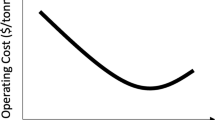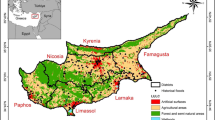Abstract
In this paper, a risk-based method implemented within a geographic information system is proposed to locate monitoring points near zones of lower hydraulic resistance for the detection of gas leaks from underground gas storage sites installed in former underground coal mines. Risk assessment is conducted considering (1) the location and extent of the mined areas and of the former underground mining infrastructures, (2) damage induced by the mining works on the upper geological formations and their associated increase in hydraulic conductivity, and (3) potential impacts on humans, based on a proxy for population density. A new physically based method is proposed to compute the damage induced by the mining activities on upper geological layers, based on a 3D reconstruction of the geometry of the voids of the upper part of the former mine and a computation of the associated ground movements using influence functions. A new type of influence function applicable to inclined coal seam is proposed. The whole methodology is applied to the former underground gas storage site of Péronnes-lez-Binche, in Belgium. Three locations are identified for the installation of new piezometers to complement the existing monitoring network.








Similar content being viewed by others
References
Aissaoui K (1999) Amélioration de la prévision des affaissements dans les mines à l’aide des approches empiriques, numériques et analytiques, PhD Thesis, Institut National Polytechnique de Lorraine, Ecole des Mines de Nancy (in French)
Aston TRC, Singh RN (1983) A reappraisal of investigations into strata permeability changes associated with longwall mining. Int J Mine Water 2(4):1–14
Azzalini A (2005) The skew-normal distribution and related multivariate families. Scand J Stat 32:159–188
Booth CJ (1986) Strata-movement concepts and the hydrogeological impact of underground coal mining. Ground Water 24(4):507–515
Booth CJ (2002) The effect of longwall coal mining on overlying aquifers, In: Mine Water Hydrogeology and Geochemistry, ed by Younger and Robins, Geological Society, London, Special Publication 198:17–45
Booth CJ (2006) Groundwater as an environmental constraint of longwall coal mining. Environ Geol 49:796–803
Cabala JM, Cmiel SR, Idziak AF (2004) Environmental impact of mining activity in the upper Silesian coal basin (Poland). Geol Belg 7(3–4):225–229
Carden SG, Goodwin PJ, Smith AJ, Thompson PG (1983) A problem of surface methane emission. Munic Eng 110(4):133–143
Choi JK, Kim KD, Lee S, Won JS (2010) Application of a fuzzy operator to susceptibility estimations of coal mine subsidence in Taebaek City. Korea. Environ Earth Sci 59(5):1009–1022
Collignon A (1995) The Continuous Cartography Project: a 3D management tool for the Walloon Region. GIS Europe 4(5):28–30
Esterhuizen GS, Karacan CO (2005) Development of numerical models to investigate permeability changes and gas emissions around longwall mining panel, In: Alaska Rocks 2005, The 40th US Symposium on Rock Mechanics, paper 05–744
He MC (2012) Considerations on CO2 storage in abandoned coal mines in China, in CO2 storage in carboniferous formations and abandoned coal mines, ed. by He et al. CRC Press/Balkema, London: 25–36
Kaufmann O, Martin T (2008) 3D geological modelling from boreholes, cross-sections and geological maps, application over former natural gas storages in coal mines. Comput Geosci 34(3):278–290
Kelsall PC, Case JB, Chabannes CR (1984) Evaluation of excavation-induced changes in rock permeability. Int J Rock Mech Min Sci & Geomech Abstr 21(3):123–135
Lagny C (2014) The emissions of gases from abandoned mines: role of atmospheric pressure changes and air temperature on the surface. Environ Earth Sci 71(2):923–929
Lambert C (2005) Contribution au développement d’outils d’aide à l’évaluation des aléas dans le cadre des PPRM Aléa « mouvement de terrain » pour des gisements pentés et filoniens. Partie 2 : Typologie des événements redoutés au droit d’exploitations pentées et/ou filoniennes. INERIS, rapport DRS-05-55102/R02: p 77 (in French)
Lamert H, Geistlinger H, Werban U, Schutze C, Peter A, Hornbruch G, Schulz A, Pohlert M, Kalia S, Beyer M, Grossmann J, Dahmke A, Dietrich P (2012) Feasibility of geoelectrical monitoring and multiphase modeling for process understanding of gaseous CO2 injection into a shallow aquifer. Environ Earth Sci 67(2):447–462
Lewicki JL, Birkholzer JT, Tsang C-F (2007) Natural and industrial analogues for leakage of CO2 from storage reservoirs: identification of features, events, and processes and lessons learned, Environ Geol 52. doi:10.1007/s00254-006-0479-7
Lewicki JL, Hilley GE, Dobeck L, Spangler L (2010) Dynamics of CO2 fluxes and concentrations during a shallow subsurface CO2 release. Environ Earth Sci 60(2):285–297
Lin S, Whittaker BN, Reddish DJ (1992) Application of asymmetrical influence functions for subsidence prediction of gently inclined seam extractions. Int J Rock Mech Min Sci 29(5):479–490
Lu M (2010) Rock engineering problems related to underground hydrocarbon storage. J Rock Mech Geotech Eng 2(4):289–297
Lu JM, Partin JW, Hovorka SD, Wong C (2010) Potential risks to freshwater resources as a result of leakage from CO2 geological storage: a batch-reaction experiment. Environ Earth Sci 60(2):335–348
Luo Y, Cheng J-W (2009) An influence function method based subsidence prediction program for longwall mining operations in inclined coal seams. Mining Sci Tech 19:592–598
National Coal Board (1975) Subsidence Engineers’ Handbook, National Coal Board Mining Department, London: p 111
Oh HJ, Ahn SC, Choi JK, Lee S (2011) Sensitivity analysis for the GIS-based mapping of the ground subsidence hazard near abandoned underground coal mines. Environ Earth Sci 64(2):347–358
Park E-S, Porathur JL, Shin HS, Choi SO (2006) Development of an asymmetric influence zone technique for subsidence and displacement prediction of moderately dipping extractions. J Korean Soc Geosys Eng 43(4):301–309
Piessens K, Dusar M (2003) CO2 sequestration in abandoned coal mines. In: Proceedings of the 2003 international coalbed methane symposium, Tuscaloosa, paper 0346, p 11
Piessens K, Dusar M (2004) Feasibility of CO2 sequestration in abandoned coal mines in Belgium. Geol Belg 7(3–4):165–180
Pokryszka Z, Lagny C (2002) Emission de gaz de mine vers la surface dans le bassin du Nord et du Pas-de-Calais. Approche méthodologique pour l’évaluation du risque et la définition des moyens de prévention, INERIS, rapport DRS-02-20815/R09 : p 44 (in French)
Proust A (1964) Etude sur les affaissements miniers dans le bassin du Nord et du Pas-de-Calais, Revue de l’Industrie Minérale 46(6–7) (in French)
Ren G, Li J (2008) A study of the angle of draw in mining subsidence using numerical modelling techniques. Elec J Geotech Eng 13(F):13
Scanlon BR, Nicot JP, Massmann JW (2002) Soil gas movement in unsaturated systems. In: Warrick AW (ed) Soil Physics Companion. CRC Press, UK, pp 297–341
Schutze C, Sauer U, Beyer K, Lamert H, Brauer K, Strauch G, Flechsig C, Kampf H, Dietrich P (2012) Natural analogues: a potential approach for developing reliable monitoring methods to understand subsurface CO2 migration processes. Environ Earth Sci 67(2):411–423
Sheorey PR, Loui JP, Singh KB, Singh SK (2000) Ground subsidence observations and a modified influence function method for complete subsidence prediction. Int J Rock Mech Min Sci 37:801–818
Shi JQ, Durucan S (2005) CO2 storage in caverns and mines, Oil Gas Sci Tech – Rev. IFP 60(3):569–571
Singh MM (1992) Mine subsidence, in SME Mining Engineering Handbook, Hartman HL (ed) Soc Min Metal Expl 938–971
Smith K (2013) Environmental hazards: assessing risk and reducing disaster, 6th edn. Routledge, Oxon 478 p
Staff MG, Sizer KE, Newson SR (1991) The potential for surface emissions of methane from abandoned mine workings. In: Methane—Facing the Problems Symposium, Nottingham, 1.1.1–1.1.9
Urban P (2004) Evaluation of hazard of mine gas emissions at the surface. Acta Montan Slov 9(3):319–322
Wells A, Strazisar B, Diehl JR, Veloski G (2010) Atmospheric tracer monitoring and surface plume development at the ZERT pilot test in Bozeman, Montana. USA. Environ Earth Sci 60(2):299–305
Wiese B, Zimmer M, Nowak M, Pellizzari L, Pilz P (2013) Well-based hydraulic and geochemical monitoring of the above zone of the CO2 reservoir at Ketzin. Germany, Environ Earth Sci 70(8):3709–3726
Acknowledgments
Fluxys S.A. funded this study as part of the measures taken to ensure the long-term safety of the storage sites of Péronnes-lez-Binche and Anderlues, as required by the decommissioning procedure imposed by regional authorities. The authors are also grateful to Prof. Dr. M. Farhad Howladar and two anonymous reviewers for providing comments and suggestions that allowed a significant improvement of the manuscript.
Author information
Authors and Affiliations
Corresponding author
Rights and permissions
About this article
Cite this article
Frippiat, C., Veschkens, M., Van Massenhove, JH. et al. A risk-based method for the design of monitoring networks for surface gas emanations from abandoned underground coal mines. Environ Earth Sci 73, 2061–2078 (2015). https://doi.org/10.1007/s12665-014-3557-2
Received:
Accepted:
Published:
Issue Date:
DOI: https://doi.org/10.1007/s12665-014-3557-2




